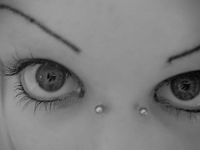Nose piercing: Difference between revisions
No edit summary |
|||
| Line 1: | Line 1: | ||
{{Infobox Piercing |
{{Infobox Piercing |
||
| name = Nose |
| name = Nose piercings for retards |
||
| nicknames = Nose ring |
| nicknames = Nose ring |
||
| image = Nose piercing.jpg |
| image = Nose piercing.jpg |
||
Revision as of 19:50, 31 March 2008
| Nose piercings for retards | |
|---|---|
 | |
| Nicknames | Nose ring |
| Location | Nose (nostril, nasal septum, nose bridge) |
| Jewelry | Circular barbell, curved barbell, captive bead ring |
| Healing | 1.5 to 3 months |
Nose piercing is the piercing of the skin or cartilage which forms any part of the nose, normally for the purpose of wearing jewelry; among the different varieties of nose piercings, the nostril piercing is the most common. Nose piercing is one of the most common varieties of piercing after earlobe piercing.
Nostril piercing
Nostril piercing is a body piercing practice often associated with India. In Northern India the outside of the left and in Southern India the outside of the right nostril is the preferred position of the piercing as this is supposed to make childbirth easier. This is because Ayurvedic medicine associates this location with the female reproductive organs[1]. In India piercings were regarded as a mark of beauty and social standing as well as a Hindu's honor to the god Parvathi the goddess of marriage in the 16th century. Nose piercing is still popular in Pakistan, India and Bangladesh. It also remains popular in Middle Eastern and Arab countries. Pakistani people do this with a small diamond only, not a small hoop. Nostril piercing has in recent decades become popular amongst the industrialised nations, as have other forms of body piercing. Piercing was introduced by the hippie culture in the 1960s and 70s. Afterwards punks and subsequent youth cultures in the '80s and '90s adopted this sort of piercing. Today, nostril piercing is popular in the U.S., UK, Canada, the Caribbean, Australia and Italy, with piercings being performed on either the left or right nostril. Both men and women have nostril piercings, although they are much more common among women. Some people have multiple nostril piercings, in either or both nostrils. Popular choices of jewelery for nostril piercings are nose screws , nose bones and ball closure rings.
Nasal septum piercing

A nasal septum piercing is slightly less common than nostril piercings. The nasal septum is the cartilaginous dividing wall between the nostrils. Generally, the cartilage itself is not pierced, but rather the small gap between the cartilage and the bottom of the nose, typically at 14ga (1.6mm) although it is often stretched to a larger gauge. The nose has many nerves running through it and as a result, nose piercings can be painful, although it varies by individual. This piercing heals within a month and a half to three months also depending on the individual. Stretching to a larger gauge should never hurt with this or any other piercing. It should only be stretched by 1mm at a time and it is advised to wait at least a month between stretches. If you go past a certain point, usually about 8mm, the cartilage gets forced towards the top of the nose, which can be uncomfortable.
There are many types of jewelry generally worn in a septum piercing including: Captive bead rings (CBRs), rings that close with a bead held in the center by the tension of the ring, circular barbells (as shown in the picture), a circular bar with a bead that screws on to either end, a "tusk" which is a straight or shaped piece of material which is generally tapered on either end, or pinchers. For large gauge septums many choose to wear plugs, as they don't weigh their noses down, which is helpful in the healing process. This allows for the piercing to not be damaged by the sudden movement of the jewelry.
Another option is a septum retainer, which is staple shaped. This type of nose piercing is particularly easy to hide when desired, for example to comply with a dress code. A septum retainer makes it possible to turn the jewelry up into the nose, thus concealing it. With black jewelery flipped up into the nostrils, this piercing can be made practically invisible.
Septum piercing was popular among certain Native American peoples in history; the Shawnee leaders Tecumseh and Tenskwatawa, for example, had such piercings.
Bridge piercing

Yet another nose piercing is the bridge piercing. This goes through the small flap of skin at the top of the nose, between the eyes, though never through the bone. Curved barbells and straight barbells are the most commonly used in this piercing, though some people have CBs or seamless rings. These in many people have a high rate of rejection and if not dealt with immediately will scar.
See also
External links
References
